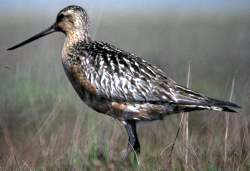|
| Query: limosa haemastica | Result: 11th of 12 | |
Godwit (Genus Limosa) - wiki
| Subject: | Godwit (Genus Limosa) - wiki
| |

| Resolution: 250x171
File Size: 12461 Bytes
Date: 2007:08:27 00:52:45
Upload Date: 2007:08:27 00:55:37
|
Godwit
From Wikipedia, the free encyclopedia
[Photo] Bar-tailed Godwit, Limosa lapponica. Creator: Bowman, Tim. Publisher: U.S. Fish and Wildlife Service
The godwits are a group of large, long-billed, long-legged and strongly migratory wading birds of the genus Limosa. They form large flocks on coasts and estuaries in winter.
They can be distinguished from the curlews by their straight or slightly upturned bills, and from the dowitchers by their longer legs. The winter plumages are fairly drab, but three species have reddish underparts when breeding. The females are appreciably larger than the males.
Family Scolopacidae
Genus Limosa
Black-tailed Godwit, Limosa limosa
Hudsonian Godwit, Limosa haemastica
Bar-tailed Godwit, Limosa lapponica
Marbled Godwit, Limosa fedoa
In addition, there are one or 2 species of fossil prehistoric godwits. Limosa vanrossemi is known from the Monterey Formation (Late Miocene, approx. 6 mya) of Lompoc, USA. Limosa gypsorum of the Late Eocene (Montmartre Formation, some 35 mya) of France may have actually been a curlew or some bird ancestral to both curlews and godwits (and possibly other Scolopacidae), or even a rail, being placed in the monotypic genus Montirallus by some (Olson, 1985). Certainly, curlews and godwits are rather ancient and in some respects primitive lineages of scolopacids (Thomas et al., 2004), further complicating the assignment of such possibly basal forms.
http://en.wikipedia.org/wiki/Godwit
| The text in this page is based on the copyrighted Wikipedia article shown in above URL. It is used under the GNU Free Documentation License. You may redistribute it, verbatim or modified, providing that you comply with the terms of the GFDL. |
|
^o^
Animal Pictures Archive for smart phones
^o^
|
|

